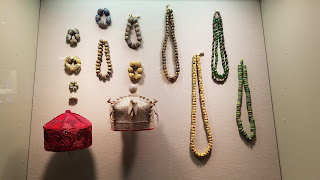 | |
| Roman glass |
To that end, visiting the Corning Museum of Glass has been on my bucket list for some time. Well - check that one off - because I was there in late August and despite spending a full day in the galleries and demonstrations, it wasn't enough...I'm going to go back!
I spent several hours in the 35 Centuries of Glass galleries - and could have spent days. The cases were filled with simple, every day pieces, extravagant decorative pieces, and of special interest to me, glass jewelry.
There were cases full of European glass beads from the 16th - 18th centuries. The beads were used as ballast in ships, then traded in African countries for other commodities
 |
| European trading beads |
 |
| Jewel toned glass and millefiori beads |
As glass making progressed beads took on the bright colors of precious stones, and the Italians developed the millefiori process - creating designs using tiny rods of glass fused together to make patterns.
 |
| Mosaic glass |
Other examples of jewelry included necklaces and earrings made from glass mosaics.
I tried my hand at fusing glass by signing up for one of the museum's "glass experiences". Working with one of the museum's resident glass-makers I made a souvenir piece of my own - a lamp work pendant.
 Working regularly with a torch as a metalsmith gave me an advantage at
the glass bench - as I was already comfortable with the idea of
manipulating material in a flame.
Working regularly with a torch as a metalsmith gave me an advantage at
the glass bench - as I was already comfortable with the idea of
manipulating material in a flame.  The staff gave me an apron, dark glasses (which makes it easier to see the glass in the flame) and "sleeves" to put on my forearms.
The staff gave me an apron, dark glasses (which makes it easier to see the glass in the flame) and "sleeves" to put on my forearms.After a short demonstration how to form the base of the pendant, and add layers of color, I sat down and got started. The whole process took about 30 minutes - and it was exciting to see the layers of glass come together and swirl into a ball. Then the glass was pressed flat to form the pendant.

The glass has to cool slowly - over about 24 hours - before it is truly finished. Because we were only spending one day in Corning, I took advantage of the museum's shipping program - and my finished pendant arrived in Austin a few days after I got home.
 I loved having the opportunity to learn something new - and to be create a wonderful souvenir in the process.
I loved having the opportunity to learn something new - and to be create a wonderful souvenir in the process.Until next time.
No comments:
Post a Comment